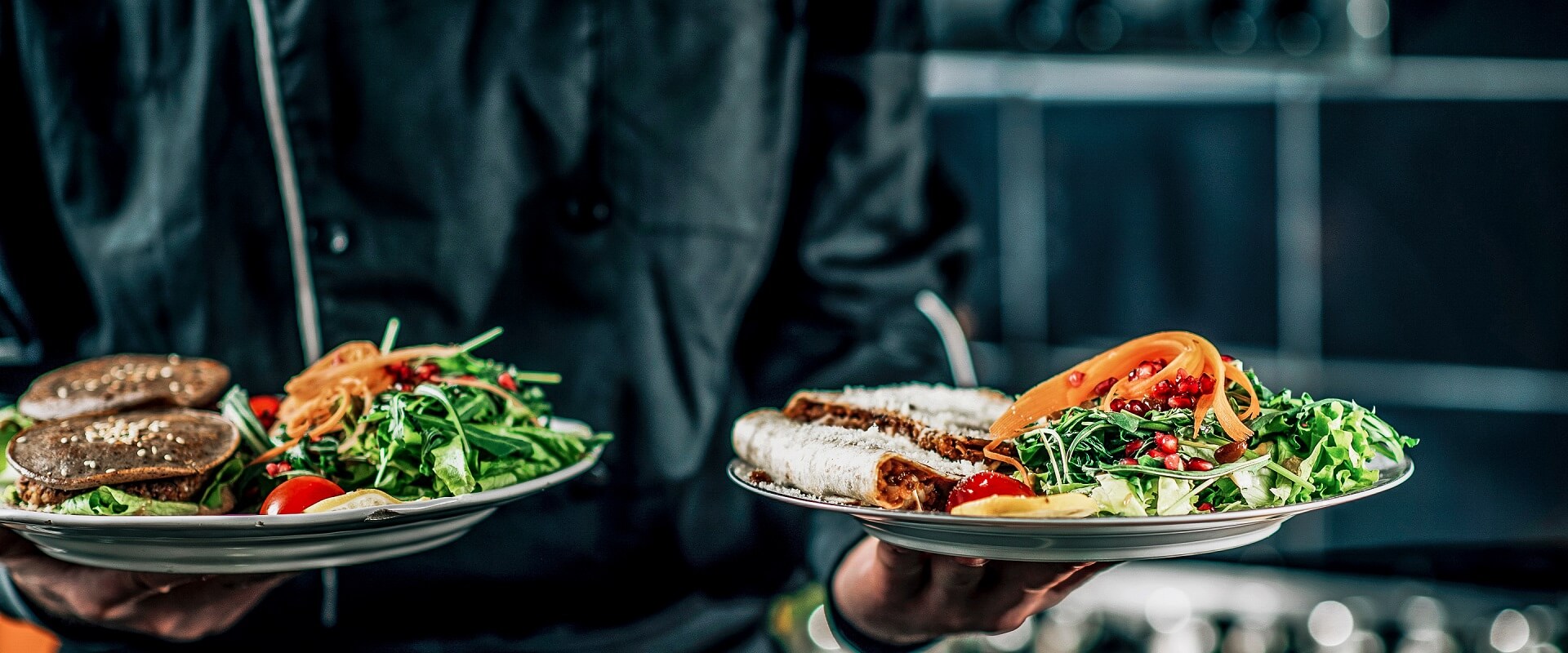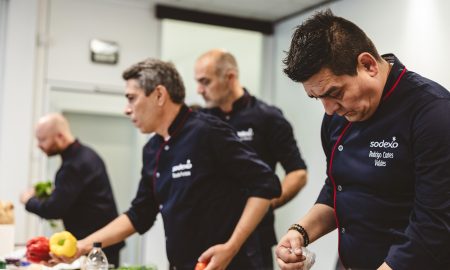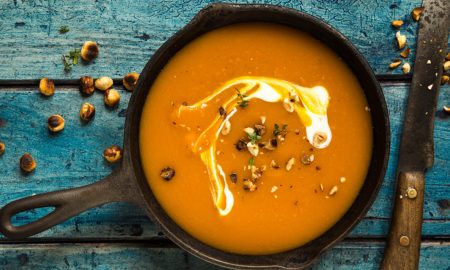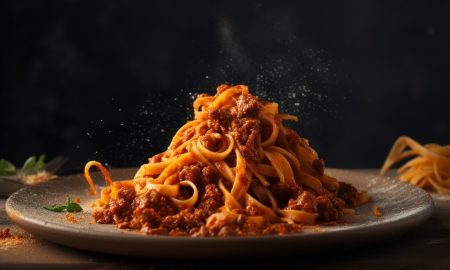We are talking about the legendary sum of 450,000,000,000 dollars. 450 billion dollars, or around 420 billion euros. This is the worldwide sales forecast for meat substitutes from 2025 to 2040, which the American management consultant Kearney calculated in a large-scale study. If, as Kearney estimates, consumption of animal products declines by a good third over the next 20 years, this sum will be borne primarily by the conventional meat industry. However, don’t worry. The meat industry remains a portly cash cow: In 2018, total sales worldwide amounted to one thousand billion dollars. One million million dollars.
ALTERNATIVE PROTEIN SOURCES
Essentially, meat substitutes come from two different sources: plant-based products and cell-based invitro meat from the lab. Fabio Ziemßen, Chairman of the German Federation for Alternative Protein Sources (BALPro) and partner at ZINTINUS, an investment fund for food tech, sees great long-term development potential in both directions.

Plant based shrimp | Image: Anke Sommer RATIONAL AG
He expects supply to diversify while reducing conventional animal-based protein supply. “Cell-based meat, called’laboratory meat’ or ‘in-vitro meat‘, has the advantage that it has all the classic properties of normal meat and can be processed and consumed with a clear conscience,” says the protein expert. “But we are talking about a future scenario. Right now, we’re still getting the infrastructure and production capacity up and running to mass-produce cell-based meat.”
FIRST IMAGING REVOLUTIONS
Plant-based meat substitutes, on the other hand, have already become more commonplace. This is due in no small part to the fact that a major shift in image has been successfully achieved in the recent past, as Fabio Ziemßen explains: “The new generation of alternative protein sources is no longer defined as much by ideology. Instead, the products are marketed much more as a lifestyle choice. As a flexitarian, you’re no longer looked at sideways if you deliberately reduce your meat consumption. The whole narrative has changed. Nowadays, plant-based eating is equated to healthy eating.”
Sieh dir diesen Beitrag auf Instagram an
Important factors that determine whether alternative protein sources are accepted include texture and taste. “People are creatures of habit. That’s why in the past consumers had a hard time getting used to saitan patties. But with a new range of ingredients, such as those made with mycelium, a substance derived from mushroom production, it’s possible to get closer to the culinary demands of the original dishes.”
GASTRONOMY AS A BOOSTER for vegan protein substitutes
Gastronomy plays an important role in this development, says Ziemßen. On the one hand, the kitchen must meet the culinary demands of the customer. “On the other hand, companies that come onto the market with new products must define gastronomy as a partner. After all, alternative protein sources often have different characteristics to conventional meat. They therefore cannot be processed one-to-one and integrated into kitchen workflows.”
Particularly in pub cuisine, tradition plays an important role. “Traditional dishes have a long history. For the mainstream consumer to accept vegan ground beef or vegan schnitzel is a process that will take time. “However, this is precisely why it is still necessary to continue with the often questioned product naming process. “You don’t need to convince vegans any more, because they eat a plant-based diet anyway. For all others, terms such as “vegan burger” or “vegan ground beef” serve as a guide.”
Sieh dir diesen Beitrag auf Instagram an
Of course, you could give new products a new name. “But let’s look at a current scenario: You are a classic meat eater and your children already deliberately eat a vegan diet. They are constantly reproaching you, for example because meat has a high CO 2 footprint. Then perhaps you try vegan baloney. And once you realize it tastes similar to classic baloney to boot, you’ll end up having an easier time making the switch to a plant-based diet.”
IT’S ALL A QUESTION OF PROTEIN
In the human body, proteins support the immune system and help regulate blood sugar levels, among other things. They boost our metabolism, help build muscle and supply the central nervous system with the necessary messenger substances. However, the human body cannot produce nine of the 20 different amino acids itself. And because body cells are also constantly regenerating, regularly absorbing proteins from your diet is downright essential for life. The German Nutrition Society (Deutsche Gesellschaft für Ernährung, DGE) recommends a daily protein intake of 0.8 grams per kilo of body weight for adults.
Many different foods contain proteins in different concentrations. In addition to meat, fish, eggs and dairy products, protein is also found in cereals (and therefore in bread and pastries), nuts and legumes such as peas, soybeans and lentils. And that’s why the industry has different options for supplying amino acids.
Sieh dir diesen Beitrag auf Instagram an
The German company Endori, for example, advertises its products with a slogan that immediately reveals the most important ingredient of its substitute program: “The best meat since peas were invented.” Additional information for interested customers: “No soy, palm fat or artificial flavors.” Founded in Bamberg in 2015 (“for the love of good food and hunger for a better future for animals, people and the environment”), the cultivation area for peas in the southern Rhineland has now increased tenfold to 500 hectares; in 2022, around 2000 tons of peas from their own harvest will be processed into meat-free burgers, sausages, schnitzels and cevapcici. In this context, the company’s public image highlights not only the short transport distances and the resulting favorable ecological footprint, but also the sustainable improvements made to the agricultural sector. “Peas are a great choice for crop rotation and have a positive impact on our soils and climate.”
TECH FOR A BETTER WORLD
Founded in Switzerland in 2019, food tech startup Planted is a spin-off of ETH Zurich, one of the leading technical universities in German-speaking countries. The results of extensive research include an innovative production process that enables a particularly long fiber structure. Pea, oat and sunflower proteins are heated at high temperatures, which results in a texture strongly reminiscent of animal meat.
Sieh dir diesen Beitrag auf Instagram an
Raising 17 million Swiss francs (around 16.5 million euros) for its international expansion plans in a financing round last year , the company’s story is based on principles that harmonize perfectly with the FridaysForFuture philosophy. “We want to revolutionize the way meat is perceived and consumed globally. It’s also about starting a fundamental shift in mindset to reduce the devastating impact of farming livestock on our planet.”
STARS AS TASTERS
One of the world’s pioneers is the listed US company Beyond Meat, which was founded by Ethan Brown in 2009. Located in California, where (healthy) food trends develop particularly quickly, the vegan flagship has long since become a darling of the entertainment industry. Oscar winner Leonardo DiCaprio, rapper Snoop Dogg, and basketball superstars Chris Paul and Kyrie Irving are among the investors, as are Bill Gates and industry giant Tyson Foods. In recent news, Kim Kardashian was hired as “Chief Taste Consultant” in May 2022, a move which received a lot of media attention.
Sieh dir diesen Beitrag auf Instagram an
Although Beyond Meat primarily replaces animal proteins with peas, it also uses brown rice, canola oil and coconut oil, potato starch and methyl cellulose. With its European headquarters in the Netherlands, the group promotes the particular benefits of its resource-saving production. According to a study by the University of Michigan, a plant-based burger patty generates 90% less greenhouse gas emissions than a conventional beef burger, consumes 46% less energy as well as 99% less water and requires 93% less land to grow.
EFFICIENCY IS THE WAY
It is impossible to pinpoint the historical origin of a meat-free diet. However, we do at least know where the word “vegan” comes from, which means completely giving up animal products. In fact, it is based on vegetarianism. Vegetarianism was first defined in the Brockhaus Encyclopedia in 1902/1903 as a type of diet where you eat eggs, milk, butter and cheese, but no meat. In 1944, the founder of the Vegan Society, Donald Watson took things one step further by eliminating all animal products from his diet. To make the distinction, five letters from the words vegetarian were removed – vegan.
In light of global climate change and the ever-increasing global population, diet and nutrition are of particular importance, as the Kearney Report previously mentioned also recognizes. Indeed, around ten billion people could live on Earth by 2050, a good 2.2 billion more than today. However, this would probably require a global rethink, if one looks at the figures of the FAO, the Food and Agricultural Organization of the UN. Around half of the world’s grain production is now used to feed 1.4 billion cows, one billion pigs, 20 billion poultry and 1.9 billion sheep and goats.
Only 37% of grain is converted directly into food for humans. It takes around 15 pounds of grain for a cow to gain two pounds. For pigs, it takes around nine pounds, and for poultry, it takes nearly five pounds. The conversion rate for plant-based proteins is considered to be much more effective: On average, around three pounds of peas, soy, beans, wheat or potatoes are enough for one kilogram of meat substitute – with a comparable nutritional profile.
ABSENCE AS A BIG PLUS
According to Kearney, other fundamental advantages of meat substitutes could lead to a rethink and a possible agricultural transformation. By consciously controlling the fat content, shelf life can be extended. In addition, there is also great cost-saving potential in the refrigeration of products in transit, for example by eliminating the risk of bacteria such as salmonella or e-coli. And it goes without saying that meat-free foods are not likely to spread epidemics such as BSE, or pandemics possibly originating from Chinese street markets…
Sieh dir diesen Beitrag auf Instagram an
HORMONES WOULD BE HISTORY
In the end – and virtually all producers of plant-based meat substitutes point this out – some of the missing tools are a big plus from the consumer’s point of view: Alternative protein sources do not require hormone treatment or medication. According to the Kearney Report, “Using antibiotics to prevent animal diseases will trigger antibiotic resistance in humans, which can lead to significant health risks.”
Nevertheless, despite our innovative spirit, Fabio Ziemßen does not believe we are losing ourselves too much in culinary science fiction. “In a few years, we will have a much more diverse food landscape. However, the claim that meat will only be available from 3D printers will not become a reality. I think we will start devoting more attention to plants again and be more resource-efficient. We will move away from factory farming and return to a more pristine form of agriculture.” And who knows? Perhaps enjoy a nice piece of beef as a side dish to a dish of fresh peas.















